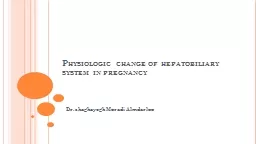

Dr shaghayegh Moradi Almdarloo Pregnancy is associated with many normal physiologic and anatomic changes that must be considered in the diagnosis of hepatobiliary diseases Physical examination ID: 927467
Download Presentation The PPT/PDF document "Physiologic change of hepatobiliary syst..." is the property of its rightful owner. Permission is granted to download and print the materials on this web site for personal, non-commercial use only, and to display it on your personal computer provided you do not modify the materials and that you retain all copyright notices contained in the materials. By downloading content from our website, you accept the terms of this agreement.
Slide1
Physiologic change of hepatobiliary system in pregnancy
Dr.
shaghayegh
Moradi
Almdarloo
Slide2Pregnancy is associated with many normal physiologic and anatomic changes that must be considered in the diagnosis of hepatobiliary diseases.
Slide3Physical examination
Spider
angiomas
and palmar erythema: classically associated with
chronic liver disease
,
common during pregnancy
and usually
disappear after delivery
.
the
hyperestrogenemia
of pregnancy is responsible for these changes, as it is in
nonpregnant
patients with cirrhosis.
Slide4In late pregnancy, physical examination of the liver is difficult because of the expanding uterus. The liver is forced up further into the chest, and a palpable liver is an abnormal finding.
Slide5Ultrasound examination
The biliary tract is usually normal. Fasting gallbladder volume and residual volume after contraction may be increased.
Slide6Pathology
Standard and ultrastructural pathologic examination of the liver of a normal pregnancy reveals no specific abnormalities
Slide7Serum proteins and lipids
Because of
hemodilution
, serum albumin levels decrease during the first trimester. The decrement becomes more accentuated as the pregnancy advances.
Serum total cholesterol and triglyceride concentrations increase markedly during pregnancy, which should be taken into account when assessing the patient's lipid profile.
Slide8Liver tests
Normal pregnancy may affect some liver biochemical tests.
Slide9Slide10Serum albumin was significantly lower in all trimesters due to
hemodilution
.
Serum alkaline phosphatase concentrations were significantly higher (up to two to four times normal) in the third trimester. This is primarily due to placental alkaline phosphatase.
Serum gamma-
glutamyl
transpeptidase
levels are reduced, and 5'-nucleotidase levels are slightly increased, indicating that the excess alkaline phosphatase is not derived from the liver.
Slide11Serum alanine aminotransferase levels were slightly higher in the second trimester, but the values were within the normal ranges. There were no differences in serum aspartate aminotransferase levels.
● Total and free bilirubin concentrations were lower in all three trimesters, while conjugated bilirubin was lower during the second and third trimester.
● Total bile acid concentrations were not significantly different.
Slide12Conclusion:
These findings suggest that in normal pregnancy, most liver biochemical tests remain within the normal range, even if slightly increased or decreased from baseline levels.
Thus, serum aminotransferase, bilirubin, or fasting total bile acid concentrations above the normal range during pregnancy may be pathologic and should prompt further evaluation.
Slide13On the other hand, hypoalbuminemia and an elevation in serum alkaline phosphatase may be a normal component of pregnancy and, if within the above ranges, do not usually indicate the presence of liver disease.
The
prothrombin time is unchanged during pregnancy, and serum fibrinogen increases in late pregnancy.
Slide14Thanks for your attention